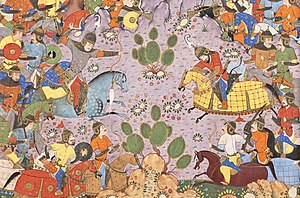Perso-Turkic war of 588–589
| First Perso-Turkic War | |||||||||
|---|---|---|---|---|---|---|---|---|---|
| Part of Göktürk–Persian wars | |||||||||
 Shahnameh illustration of Bahram Chobin fighting King Sawa | |||||||||
| |||||||||
| Belligerents | |||||||||
| Sasanian Empire |
Western Turkic Khaganate Hephthalite principalities | ||||||||
| Commanders and leaders | |||||||||
|
Bahram Chobin Bahram Siyavashan Nadre Gushnasp Izad Gushnasp |
Bagha Khagan † Yil-Tegin (POW) Birmudha-tigin (POW) | ||||||||
| Strength | |||||||||
| 12,000[1] | unknown | ||||||||
The Perso-Turkic War was fought during 588–589[2] between the Sasanian Empire and Hephthalite principalities and its lord the Göktürks. The conflict started with the invasion of the Sasanian Empire by the Turks and ended with a decisive Sasanian victory and the reconquest of lost lands.
Background
In 557, Khosrow I (r. 531–579), the king (shah) of the Sasanian Empire, who had greatly increased the authority of his empire, decided to put an end to the Hephthalite Empire domination over Central Asia. He thus allied with the Göktürks in order to defeat the Hephthalites. The campaign was successful and the region north of the Oxus went to the Turks whilst the south came under Sasanian rule. An agreement was established between Khosrow I and the Turkic Khagan Istämi which set the Oxus as the frontier between the two empires. However, in 588, the Turkic Khagan (known as Sabeh/Saba in Persian sources), together with his Hephthalite subjects, invaded the Sasanian territories south of the Oxus, where they attacked and routed the Sasanian soldiers stationed in Balkh, and then proceeded to conquer the city along with Talaqan, Badghis, and Herat.[3]
War
An emergency council of war was held in Ctesiphon in which Bahram Chobin, a cavalry commander from the Parthian noble family of Mihran, was chosen to lead an army against the Turks and was given the governorship of Khorasan. Bahram's army gathered at Nishapur and consisted of 12,000 hand-picked soldiers, which included cavalry, Dailamite infantry, and war elephants.[4][5]
In 588 CE, the Sasanians set out from Nishapur to confront the Turks in eastern Khorasan, where they met to battle. Bahram organized his forces by placing his infantry in the center with the cavalry directly behind them and war elephants on the right and left. Bahram selected 100 Pahlavan soldiers to accompany him on an ambush at the position of the Khagan, where he was seated on a golden throne observing the battle. The battle began with the Sasanian war elephants on the right and left attacking the Turkic flanks on both sides, followed by the Sasanian infantry splitting to allow the cavalry behind them to smash into the Turkic center. Meanwhile, Bahram and the 100 Pahlavans assaulted the Khagans position. The Khagans bodyguards were slaughtered, and the Khagan was killed. The Khagans son, Yil-Tegin, managed to escape along with some others to a castle named Avaze. Bahram Chobin's army pursued Yil-Tegin and besieged the castle, eventually forcing the Turks to surrender.[6] In 589, the Sasanians re-conquered Herat and Balkh, where Bahram captured the Turkic treasury and the golden throne of the Khagan.[7][8] He then proceeded to cross the Oxus river and won a decisive victory over the Eastern Turks, personally killing the Khagan, Bagha Qaghan (Sawa), with an arrowshot.[9] He managed to reach as far as Baykand, near Bukhara, and also contain an attack by the son of the deceased Khagan, Birmudha, whom Bahram had captured and sent to the Sasanian capital of Ctesiphon.[8] Birmudha was well received there, and was forty days later sent back to Bahram with the order that the Turkic prince should get sent back to Transoxiana.[8] The Sasanians now held suzerainty over the Sogdian cities of Chach and Samarkand, where the Sasanian shah, Hormizd IV, minted coins.[10]
Ferdowsi's Shahnameh (C.E. 1010) describes in legendary detail the dealings of Bahram Chobin and the Turkic "King Sawa" before and during the battle in which Bahram with his 12,000 men kills Sawa.[11]
References
- ^ https://i.4pcdn.org/tg/1421080734674.pdf
- ^ Buddha Prakash, Studies in Indian History and Civilization, Shiva Lal Agarwala, 1962, p. 318.
- ^ Rezakhani 2017, p. 177.
- ^ Farrokh, Kaveh. Shadows in the Desert. pp. 245–246.
- ^ Shahbazi 1988, pp. 514–522.
- ^ Jaques 2007, p. 463.
- ^ Pourshariati, Parvaneh. Decline and Fall of the Sasanian Empire. p. 126.
- ^ a b c Rezakhani 2017, p. 178.
- ^ Farrokh, Kaveh. Sasanian Elite Cavalry. p. 53.
- ^ Rezakhani 2017, p. 178, According to Rezakhani, coins of the years 3-5 (582-584) of the reign of Hormizd IV (579–590) were minted in Khulm and Samarkand, and coins of year 6 (585) were minted in Chach, and should "probably" be assigned to this period, attesting to the "northernmost extent of Sasanian power, extending beyond the Syr Darya/Jaxartes" p.176.
- ^ Volume VIII of the online Shah Nama at [1], under "The Reign of Hurmuzd, Son of Nushirwan."
Sources
- Sims-Williams, Nicholas (2009). "Kadagistān". Encyclopaedia Iranica, Vol. XV, Fasc. 3. London et al. pp. 324–325.
{{cite encyclopedia}}: CS1 maint: location missing publisher (link) - Rezakhani, Khodadad (2017). ReOrienting the Sasanians: East Iran in Late Antiquity. Edinburgh University Press. pp. 1–256. ISBN 9781474400305.
- Frye, Richard Nelson (1984). The History of Ancient Iran. C.H.Beck. pp. 1–411. ISBN 9783406093975.
The history of ancient iran.
- Shahbazi, A. Sh. (1988). "Bahrām VI Čōbīn". Encyclopaedia Iranica, Vol. III, Fasc. 5. London et al. pp. 514–522.
{{cite encyclopedia}}: CS1 maint: location missing publisher (link) - Litvinsky, B. A.; Dani, Ahmad Hasan (1996). History of Civilizations of Central Asia: The crossroads of civilizations, A.D. 250 to 750. UNESCO. pp. 1–569. ISBN 9789231032110.
- Bivar, A. D. H. (2003). "Hephthalites". Encyclopaedia Iranica, Vol. XII, Fasc. 2. London et al. pp. 198–201.
{{cite encyclopedia}}: CS1 maint: location missing publisher (link) - Howard-Johnston, James. "Ḵosrow II". Encyclopaedia Iranica, Online Edition.
- Jaques, Tony (2007). Dictionary of Battles and Sieges: F-O. Greenwood Publishing Group. pp. 1–1354. ISBN 9780313335389.
